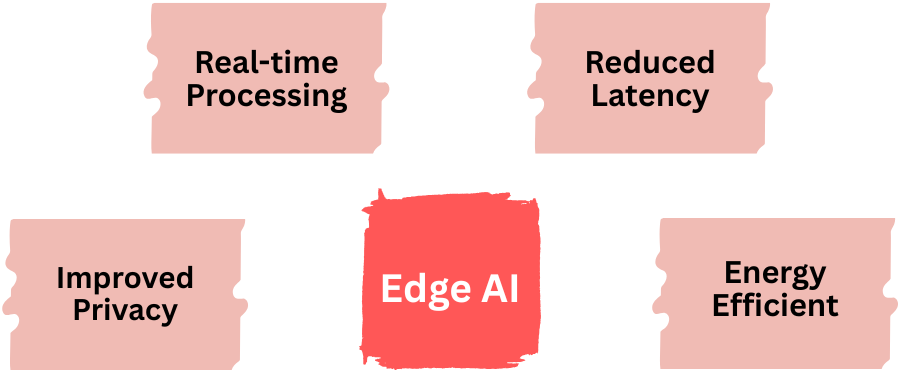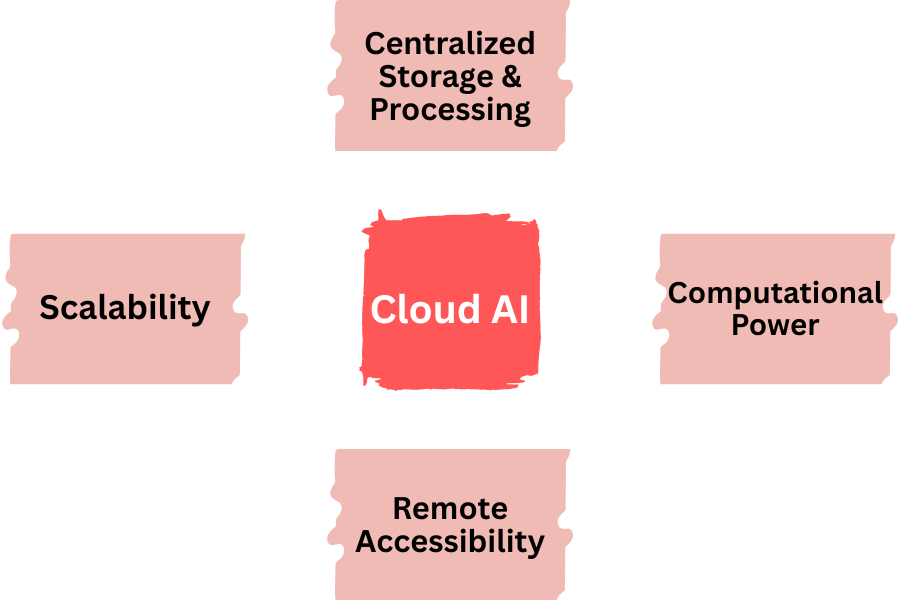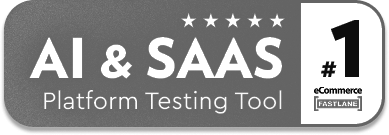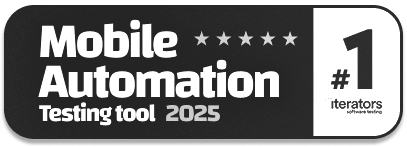Edge AI vs. Cloud AI
|
|
The field of artificial intelligence (AI) is growing rapidly. As a result, there is a growing requirement to process data effectively to balance speed, scalability, and resources. AI deployment has been dominated by Edge AI and Cloud AI, the two main architectures.
Whereas Edge AI deals with real-time intelligence in data generation, Cloud AI uses the power of centralized processing. This article will discuss the significant differences between these two deployments.
What is Edge AI?
Edge AI is a type of AI deployment in which the AI models are deployed directly on the edge of the devices (edge of the network, close to the data).
An edge device is a piece of hardware used to control data flow at the edge (boundary) between two networks. Edge devices serve as network entry or exit points, though they also perform other roles.
Edge devices for AI are built with sensors and microcontrollers that help them collect physical data and host edge AI models for local processing. Internet of Things (IoT) devices, smartphones, drones, smart thermostats, surveillance cameras, soil moisture monitors, and industrial sensors are some edge devices.
So, in Edge AI, the data is processed locally on the edge device itself instead of being sent to a remote server or cloud. This enables real-time decision-making and faster responses.
Salient Features of Edge AI
Below are some of the salient features of Edge AI.

- Real-Time Processing: In the case of Edge AI, data processing and AI inference are local. Hence, the responses and decisions are instantaneous.
- Reduced Latency: Since processing is local, data doesn’t travel to a centralized server. As a result, the latency (delay) between data generation and action is minimal.
- Improved Privacy: Data is local to the Edge device. Thus, it is secured and reduces the risk of privacy breaches. Additionally, sensitive data need not be transmitted over the cloud.
- Energy Efficient: In the case of edge AI, computations that run on resource-constrained devices are optimized, which significantly improves power efficiency.
Working of Edge AI
AI edge setup models are first trained on a central server or in the cloud. Then, they are deployed to the edge devices for drawing inference. Thus, once deployed, the models run predictions locally. There is no need for consistent interaction with the cloud.
Here’s a simplified overview of the Edge AI pipeline:
- Train AI Model (in cloud with large datasets)
- Optimize & Compress (for low-power devices)
- Deploy to Edge Device
- Run Inference Locally (fast, private, offline)
- Sync with Cloud for updates or insights (Optional)
Edge AI is particularly useful when:
- Low latency is essential (e.g., real-time control systems).
- Bandwidth is limited (e.g., remote locations).
- Data privacy is critical (e.g., personal health data).
- Connectivity is unreliable or expensive.
Use Cases of Edge AI
- Robotic Process Automation (RPA): Smart robots use Edge AI to make real-time decisions based on sensor input without relying on cloud connectivity.
- Emergency Preparedness: Edge AI can support local contingency planning during surges or extreme weather events, ensuring energy resources are rerouted or managed proactively.
- Medical Imaging: AI-powered devices like portable X-ray or ultrasound machines can analyze scans on-device, speeding up diagnosis in remote or emergency locations.
- Smartphones & Wearables: Edge AI enables facial recognition, photo enhancements, battery optimization, and health tracking in real time on devices like smartphones and smartwatches.
- In-Store Assistance: Retail environments can also deploy edge-based assistants that help customers navigate stores, check inventory, and receive product suggestions on the spot.
What is Cloud AI?
In the case of cloud AI, the deployment is in the cloud, to be more precise, in a centralized cloud infrastructure. Data is collected from different sources and uploaded to remote servers. Remote servers have large-scale AI models that help process data using high-performance computing resources.
Contrary to data processing locally, processing on remote servers is large-scale. Hence, in cloud AI, data analysis is compelling, and batch processing of large datasets is possible.
Salient Features of Cloud AI
The figure below shows salient features of cloud AI.

- Scalability: With cloud AI, infrastructure can be scaled dynamically. This helps handle large amounts of data while complex and resource-heavy AI models run efficiently.
- Centralized Storage and Processing: Cloud AI has a centralized location for data storage and processing. This makes it easier to train models on large datasets and integrate data from various sources.
- Computational Power: Advanced GPUs and TPUs are provided in Cloud AI infrastructure, making them ideal for training deep learning models and handling high-performance tasks.
- Remote Accessibility: AI models and data can be accessed remotely, enabling distributed teams to collaborate on other AI projects.
Working of Cloud AI
In a cloud AI architecture, data is collected from devices or systems and transmitted to a remote cloud infrastructure for processing. Cloud servers handle training and inference, using high computational power to process large volumes of data in real time or asynchronously.
Here’s a simplified workflow:
- Data Collection (from apps, users, devices)
- Data Processing & Storage (clean, format, store)
- Model Training (on cloud GPUs/TPUs)
- Model Deployment (expose via APIs or SDKs)
- Model Inference (users/applications make predictions)
- Continuous Improvement (retrain & redeploy as needed)
Cloud AI is ideal when:
- Massive data processing and model training are needed
- Applications require global scalability
- Centralized control, monitoring, and updates are important
- You need pre-built AI services (like speech-to-text, vision APIs, or AutoML)
Use Cases of Cloud AI
- Personalized Medicine: By analyzing electronic health records, genetic data, and patient history, AI can recommend tailored treatment plans, allowing clinicians to provide more effective care with greater efficiency.
- AI Chatbots & Virtual Assistants: By using NLP (Natural Language Processing) and ML models, chatbots deliver real-time support, handle customer service inquiries, and even resolve disputes, without human intervention.
- Fraud Detection: AI models continuously monitor transactions and detect unusual behavior in real time, flagging potential fraud for immediate investigation.
- Personalized Learning: AI-driven platforms adapt lesson plans to individual students’ performance, enabling customized learning journeys that cater to each student’s pace and style.
- Quality Control: AI-powered vision systems inspect manufactured products for defects in real time, helping maintain consistency and quality standards.
Key Differences: Edge AI and Cloud AI
Having understood the basics of edge AI and cloud AI, let’s now discuss the differences between the two deployment architectures. The following table summarizes key differences between edge AI and cloud AI based on significant factors.
| Aspect | Edge AI | Cloud AI |
|---|---|---|
| Architecture |
|
|
| Latency and Real-Time Responses |
|
|
| Privacy and Security |
|
|
| Computing Power and Storage Cost |
|
|
| Dependence on Internet Connectivity |
|
|
| Scalability & Power |
|
|
| Real World Applications |
|
|
testRigor and Gen AI
testRigor is a generative AI-powered intelligent no-code test automation platform. This AI agent supports different types of testing, such as native desktop, web, mobile, API, visual, exploratory, AI features, mainframe, graph, Flutter apps, accessibility testing, and many more, using just plain English.
It is designed to help manual testers, business users, and developers automate complex test scenarios without writing any code. Read: All-Inclusive Guide to Test Case Creation in testRigor. It eliminates test flakiness, automatically adapts to UI changes, and integrates seamlessly with CI/CD workflows. Check out the complete list of features.
Conclusion
The above differences between edge AI and cloud AI suggest that both are critical technologies in the AI environment. Each offers unique benefits. Edge AI is suitable for applications where low latency, data privacy, and real-time responses are essential, such as autonomous vehicles, wearables, IoT, and so on. On the other hand, cloud AI is ideal for large-scale, resource-centred tasks that need high computational power, such as NLP, big data analytics, and deep learning.
The choice between edge AI and cloud AI ultimately depends on the above factors and application requirements. In many cases, however, a hybrid approach is preferred, wherein both edge AI and cloud AI are combined to achieve the best of both models.
| Achieve More Than 90% Test Automation | |
| Step by Step Walkthroughs and Help | |
| 14 Day Free Trial, Cancel Anytime |












